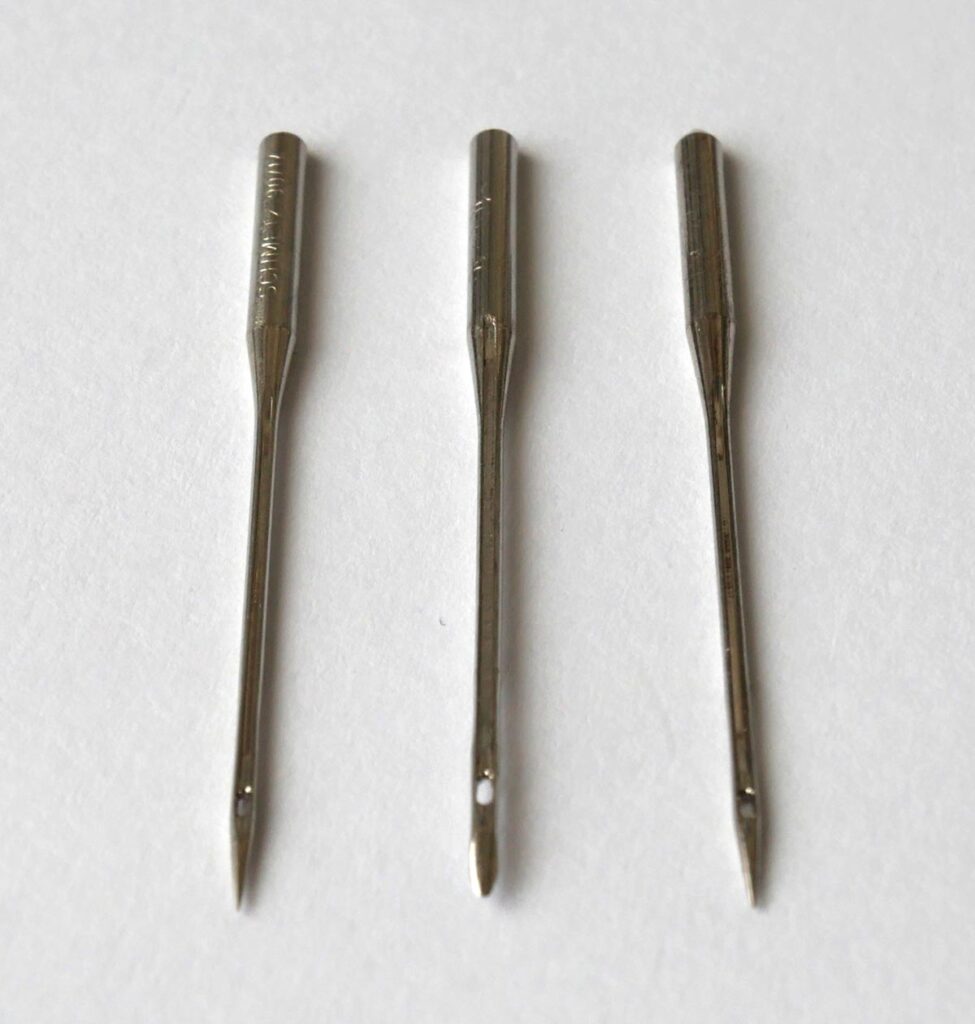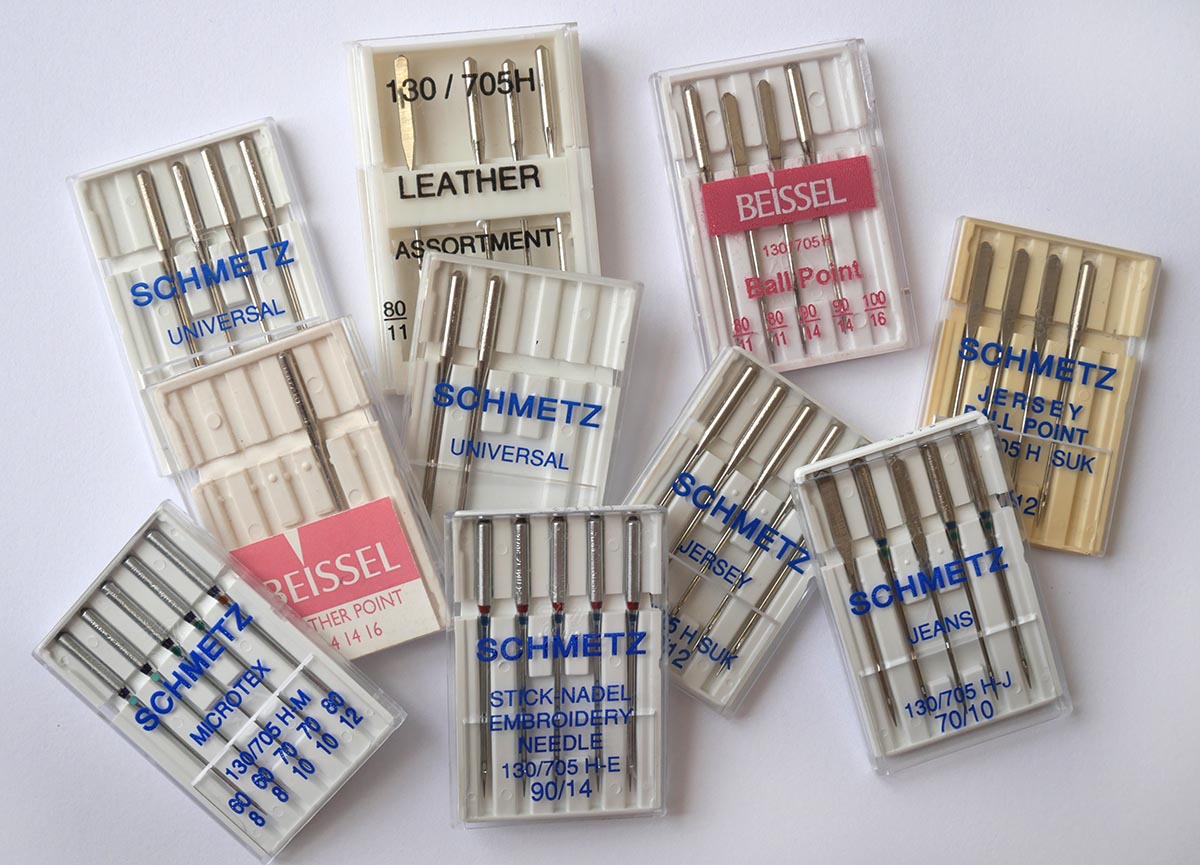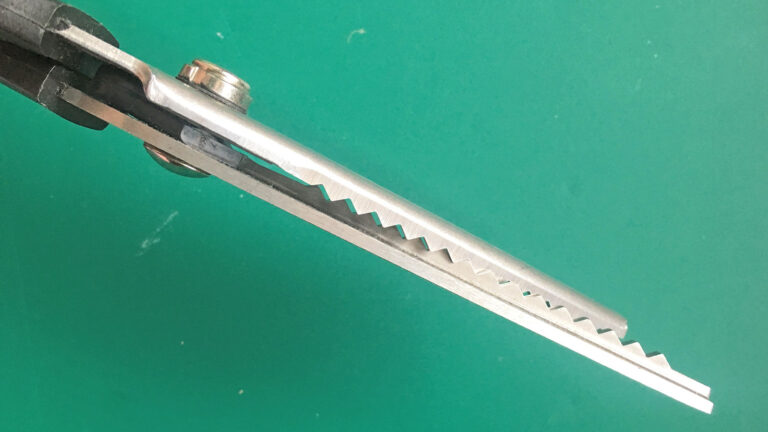Types Of Sewing Machine Needles
There are so many types of sewing machine needles that I thought it was time to create a small guide similar to my one on sewing machine presser feet.
While the universal sewing needle is universally known (ha ha) there are many other machine needle types that are not – so this guide should help you learn about the anatomy of a sewing machine needle, the different types of needles and when you should use each one.
Of course, if you haven’t yet got one, do check out my guide on buying a sewing machine – it will help you to buy the right sewing machine for your needs! – and if you’re not planning on machine sewing yet, you’ll want to learn more about hand sewing needles.
Some of the links in this article are affiliate links. This means that I may receive a fee at no extra cost to you if you purchase a recommended product.

Anatomy Of A Sewing Machine Needle
Let’s start with the anatomy of a sewing machine needle so that you know what I’m referring to when I am talking about the different needle types.
A sewing needle has several parts:
- Eye – the hole that we feed our thread through
- Groove – this is at the front of the needle and helps the thread to lie nicely when coming down fro the thread guide above
- Point – the tip of the needle, the point differs depending on your needle type
- Scarf – a slight ‘curve’ at the back of the needle which helps the hook from the bobbin area to pass and not catch on the needle
- Shaft – the thinner length of the needle, just below the shank and down to the point
- Shank – this is the thicker upper section, with a flat edge, which is gripped by the needle holder
- Shoulder – the tapered section where the shank narrows down to the shaft of the needle
Choosing The Right Needle
Choosing the right needle for your sewing machine comes down to the project you’ll be sewing. Considerations include:
- Fabric type
- Fabric weight
- Thread type
Let’s look at each in turn!
Fabric Type

I have a very extensive guide here on different fabric types, so I’ll just touch on it here, but sewing different fabric types will require different needles.
- Woven fabrics – can be sewn with universal, jeans, embroidery or microtex needles
- Knit fabrics – can be sewn with knit, ballpoint or stretch needles
- Leather – should be sewn only with dedicated leather needles
Fabric Weight

All fabrics comes in different weights, from light weight, super sheer fabrics like chiffon to much heavier, hard wearing fabrics like denim and canvas.
It’s important to choose the right needle size for the fabric weight that you will be sewing, as the using the wrong needle can result in your sewing machine needle breaking!
You would not use a 90/14 needle on a fine chiffon and you would use a 70/10 universal on a heavy weight denim.
Thread Type

The type of thread you plan to sew with also has an impact on the needle you insert into your sewing machine.
Topstitching thread is much thicker than regular sewing thread, and requires a needle with a bigger eye to accommodate the thread weight.
Note that machines can be as picky about threads as I am about coffee brands – if your thread keeps breaking again and again and you’ve checked all possible causes, it could be that the machine and the thread are just incompatible!
Sewing Machine Needle Types

So, now we’ve covered the main considerations when choosing a sewing machine needle, lets look at the different types, and when you’d use them.
Here’s a list of the different types of sewing machine needles:
- Ballpoint needles
- Embroidery needles
- Jeans needles
- Leather needles
- Microtex needles
- Quilting needles
- Stretch needles
- Topstitch needles
- Universal needles
Ballpoint Needles
Ballpoint needles (also referred to as jersey needles) are specifically for closely knitted fabrics. They have a slightly rounded point rather than a sharp point. This blunt point allows the needle to penetrate the knitted fibres in a non-damaging way so that the knit stitches are not snagged or snapped.
Embroidery Needles
Used when sewing with embroidery thread, an embroidery needle has a special scarf to prevent damage to the thread and a bigger eye. The large eye is better for threading, otherwise you might need to use a needle threader
Jeans Needles
This needle type is great for highly woven fabrics and is designed to sew heavier woven fabrics like denim and canvas. The ‘jeans needle‘ also comes in a variety of sizes too, and is often called a ‘denim needle’.
Leather Needles

These are needles that work with leather and other leather-like materials, like imitation leather. The point on a leather needle is cut differently to have a sharp tip, which allows the needle to cut into the leather to make a hole when sewing leather.
Larger needles will make larger holes as when the cutting point has gone through the leather it is not possible to hide the large hole the way we can with a woven type of fabric.
Microtex Needles
These microtex needles are thinner, with a sharper point, and are great for sewing silks and other very fine or delicate fabric types. The finer tip means that they’re great for foiled or coated fabrics too.
Quilting Needles
A very specific needle type, Quilting needles have an extra strong shaft as well as a sharp point. These are considered essential if you will be quilting through multiple layers of fabric.
Stretch Needles
Stretch needles are used for stretch fabrics – they have a slightly rounded tip to lessen damage to the fibres when sewing.
Stretch fabrics can be knitted fabrics or woven fabrics with a stretch factor added in which is usually lycra or spandex! Again the size of the needle can vary but these are the best needle for any fabric with a stretch factor included.
Topstitch Needles
Needles that are sold as topstitching needles are designed for sewing with thicker thread size to create decorative work in the form of topstitched lines.
They have a larger eye and a stronger shaft as topstitching thread is thicker than regular sewing thread, and this then prevents the needle breakage that would happen if a regular or universal needle was used.
Universal Needles

These sharp point universal needles are suitable for woven fabrics. These sharp needles come in different sizes, each being suitable for a specific fabric weight and will work with any home sewing machine. The eye of the needle is standard in shape and size, and these are the most commonly used needles used in both home and industrial sewing machines.
Needle Variations
Other variations for sewing machine needles include:
- Twin needles for topstitching or decorative stitches
- Twin needles for stretch and knit fabrics (used predominantly on coverstitch machines)
- Triple needles, again used for stitch fabrics
Sewing Machine Needle Sizes

You’ve probably wondered what the numbers on sewing machine needles mean? Those numbers are the needle sizings!
Sewing machine needles come in different sizes, and choosing the right size needle is important. Here’s a guide to the common sizes and the fabrics that you can sew with them in the needle system:
- 70/10 needles are used for very fine fabrics, such as chiffons, lace and organza, as a larger needle will leave a visible hole in the fabric
- 80/12 needles are used for lightweight fabrics such as cotton lawn and polyester satin.
- 90/14 needles are used for this is a standard needle size for more medium weight fabrics like velvet, linen, various knit fabrics, calico etc
- 100/16 needles are used for work well for medium weight denim and canvas and thinner leathers
- 110/18 and above needles are used for heavy weight fabrics. Thick canvas and denim, thick leather, faux furs etc.
Note that the different numbers are down to US and European size methods.
Finally, always consider the fabric weight and think about the ‘strength’ of the needle needed.
Sewing Machine Needle Brands
Which brands should you use for sewing machine needles?
I use Schmetz 95% of the time, as they are the leading brand for sewing machine needles. These are the sewing machine needles that I use and love:
- Schmetz universal needles (mixed sizes)
- Schmetz jersey ballpoint needles (size 90/14) or this mixed set
- Schmetz microtex needles (size 80/12)
- Schmetz embroidery needles (mixed sizes)
- Schmetz jeans needles (mixed sizes)
- Schmetz quilting needles (size 90/14)
- Schmetz stretch needles (size 90/14)
- Schmetz leather needles (size 90/14)
- Schmetz topstitching needles (size 90/14)
Other brands that you can use are Organ and Singer, but as I rarely use anything other than Schmetz sewing needles, I cannot recommend others.
If you’ve enjoyed this, do check out my free beginner friendly sewing course over on YouTube – I cover much more inside this sewing beginners course, and you’ll feel much more confident using your sewing machine afterwards!







Dealing with trouser adjustments. As we grow older our butts sag and how do would you deal with this adjustment in trousers?